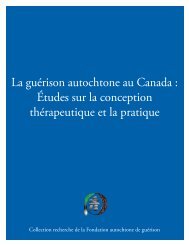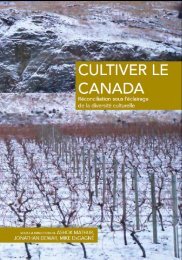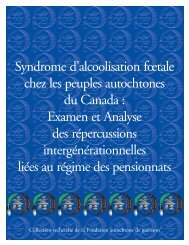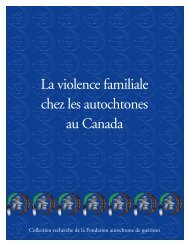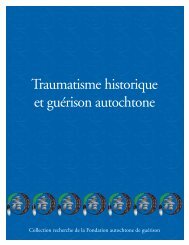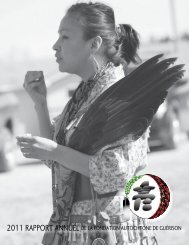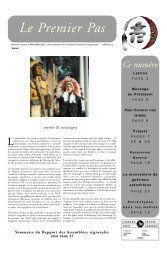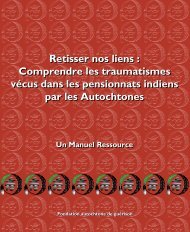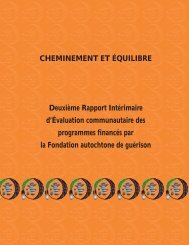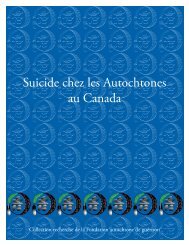- Page 1 and 2:
Rapport final de la Fondation autoc
- Page 3:
Rapport final de la Fondation autoc
- Page 6 and 7:
Table des matières Définitions ..
- Page 8 and 9:
5.13 Stratégies de guérison à l
- Page 10 and 11:
Figures Figure 1) Efficacité dépa
- Page 12 and 13:
Tableau 20) Fréquentation des pens
- Page 14 and 15:
Définitions Ce glossaire des terme
- Page 16 and 17:
dÉfinitions Meilleures pratiques o
- Page 19 and 20:
La Mission Pensionnat indien St Mar
- Page 21 and 22:
v volume i : un cheminement de gué
- Page 24 and 25:
École Bishop Horden Memorial (Pens
- Page 26 and 27:
1.2 Mission et mandat volume i : un
- Page 28 and 29:
volume i : un cheminement de guéri
- Page 31 and 32:
Une Participante au rassemblement n
- Page 33 and 34:
volume i : un cheminement de guéri
- Page 35 and 36:
0 chapitre deux Refaçonner l’ide
- Page 37 and 38:
volume i : un cheminement de guéri
- Page 39 and 40:
excuses officielles présentées pa
- Page 41 and 42:
6 chapitre deux Les paragraphes de
- Page 43 and 44:
volume i : un cheminement de guéri
- Page 45 and 46:
0 chapitre deux En tant que qualifi
- Page 47 and 48:
volume i : un cheminement de guéri
- Page 49 and 50:
volume i : un cheminement de guéri
- Page 51 and 52:
6 chapitre deux En plus d’avoir p
- Page 53:
volume i : un cheminement de guéri
- Page 56 and 57:
chapitre trois 3.1 introduction Év
- Page 58 and 59:
chapitre trois 3.2 affectation du F
- Page 60 and 61:
chapitre trois Le tableau 2 présen
- Page 62 and 63:
chapitre trois Figure 2) Nombre tot
- Page 64 and 65:
chapitre trois Figure 4) subvention
- Page 66 and 67:
chapitre trois leurs décisions pou
- Page 68 and 69:
chapitre trois la FADG a assuré la
- Page 70 and 71:
chapitre trois avait été le cas a
- Page 72 and 73:
chapitre trois En 2000, la FADG a e
- Page 74 and 75:
chapitre trois sa responsabilité.
- Page 76 and 77:
chapitre trois deux journaux franco
- Page 78 and 79:
chapitre trois Figure 5) Ét
- Page 80 and 81:
chapitre trois spécialisées dans
- Page 82 and 83:
chapitre trois Atlantique Québec F
- Page 84 and 85:
chapitre trois La situation des Mé
- Page 86 and 87:
chapitre trois 3.4.3 Finances La pr
- Page 88 and 89:
chapitre trois subvention suppléme
- Page 90:
chapitre trois Autochtones visant l
- Page 93 and 94:
chapitre quatre 4.1 introduction É
- Page 95 and 96:
chapitre quatre Dès le commencemen
- Page 97 and 98:
chapitre quatre Figure 8) Fondation
- Page 99 and 100:
chapitre quatre FADG et des annonce
- Page 101 and 102:
chapitre quatre À l’échelle nat
- Page 103 and 104:
chapitre quatre ce qui est des acti
- Page 105 and 106:
chapitre quatre Figure 10) Particip
- Page 107 and 108:
chapitre quatre Figure 12) Particip
- Page 109 and 110:
chapitre quatre (médian=25 %, n=15
- Page 111 and 112:
chapitre quatre postes et les perso
- Page 113 and 114:
chapitre quatre Tableau 7) besoins
- Page 115 and 116:
chapitre quatre 3 le climat où la
- Page 117 and 118:
chapitre quatre Les litiges liés a
- Page 119 and 120:
chapitre quatre Figure 15) Cheminem
- Page 121 and 122:
chapitre quatre culpabilité, la co
- Page 123 and 124:
chapitre quatre qu’on raconte ce
- Page 125 and 126:
chapitre quatre Figure 16) arrimer
- Page 127 and 128:
chapitre quatre Judith Herman dans
- Page 129 and 130:
chapitre quatre Les types de servic
- Page 131 and 132:
chapitre quatre analysées pour arr
- Page 133 and 134:
chapitre quatre avec la sexualité
- Page 135 and 136:
chapitre quatre Alors que la plupar
- Page 137 and 138:
chapitre quatre Bien des projets on
- Page 139 and 140:
chapitre quatre Tableau 12) Capacit
- Page 141 and 142:
chapitre quatre Étape 3 : l’ét
- Page 143 and 144:
chapitre quatre 4.9.1 Étape un : l
- Page 145 and 146:
chapitre quatre propre épanouissem
- Page 147 and 148:
chapitre quatre Le nombre d’emplo
- Page 149 and 150:
chapitre quatre des données de bas
- Page 151 and 152:
chapitre quatre lit occupé par un
- Page 153 and 154:
chapitre quatre Figure 23) Financem
- Page 155 and 156:
chapitre quatre Figure 25) appréci
- Page 157 and 158:
chapitre quatre Capacité des autoc
- Page 159 and 160:
chapitre quatre Participation au ch
- Page 162 and 163:
Photo : Bob Mesher
- Page 164 and 165:
volume i : un cheminement de guéri
- Page 166 and 167:
6 chapitre cinq La recherche visant
- Page 168 and 169:
volume i : un cheminement de guéri
- Page 170 and 171:
0 chapitre cinq Guerre mondiale. Po
- Page 172 and 173:
Processus de décolonisation de lae
- Page 174 and 175:
volume i : un cheminement de guéri
- Page 176 and 177:
6 chapitre cinq ou qu’il n’y ai
- Page 178 and 179:
Centre for indigenous sovereignty,
- Page 180 and 181:
0 chapitre cinq celle des pensionna
- Page 182 and 183:
asini Kanepawit Counselling service
- Page 184 and 185:
volume i : un cheminement de guéri
- Page 186 and 187:
6 chapitre cinq bien d’orienter v
- Page 188 and 189:
volume i : un cheminement de guéri
- Page 190 and 191:
60 chapitre cinq Presque le quart (
- Page 192 and 193:
6 chapitre cinq Hailika’as Heilts
- Page 194 and 195:
6 chapitre cinq Tableau 15) guéris
- Page 196 and 197:
66 chapitre cinq [traduction] « la
- Page 198 and 199:
6 chapitre cinq présentations, on
- Page 200 and 201:
0 chapitre cinq • pour former des
- Page 202 and 203:
Conseil des Montagnais de Natashqua
- Page 204 and 205:
volume i : un cheminement de guéri
- Page 206 and 207:
6 chapitre cinq • la massothérap
- Page 208 and 209:
une prière est récitée pour clor
- Page 210 and 211:
0 chapitre cinq à l’égard des a
- Page 212:
volume i : un cheminement de guéri
- Page 215 and 216:
chapitre six Mappage du cheminement
- Page 217 and 218:
chapitre six l’isolement de la fa
- Page 219 and 220:
chapitre six des pensionnats. Comme
- Page 221 and 222:
chapitre six connaissance/son savoi
- Page 223 and 224:
chapitre six [traduction] Les prés
- Page 225 and 226:
chapitre six Les projets financés
- Page 227 and 228:
chapitre six * altérations de la c
- Page 229 and 230:
chapitre six 6.6.1 les effets de la
- Page 231 and 232:
chapitre six qu’on avait créé;
- Page 233 and 234:
chapitre six De l’ensemble des pr
- Page 235 and 236:
chapitre six à 38,2 pour cent (res
- Page 237 and 238:
chapitre six de guérison. Dans le
- Page 239 and 240:
chapitre six Poteau indicateur 10 e
- Page 241 and 242:
chapitre six • l’indication qu
- Page 243 and 244:
chapitre six Particulièrement au c
- Page 246 and 247:
Participants au rassemblement natio
- Page 248 and 249:
Mais, comme nous l’ont dit les au
- Page 250 and 251:
6 volume i : un cheminement de gué
- Page 252 and 253:
volume i : un cheminement de guéri
- Page 254 and 255:
0 volume i : un cheminement de gué
- Page 256 and 257:
volume i : un cheminement de guéri
- Page 258 and 259:
Tableau 19) Fréquentation des pens
- Page 260 and 261:
6 7.4.2 Dénombrement des générat
- Page 262 and 263:
Tableau 21) Fréquentation des pens
- Page 264 and 265:
0 Figure 29) est-ce que vos parents
- Page 266 and 267:
Figure 31) Pourcentage des personne
- Page 268 and 269:
234 volume i : un cheminement de gu
- Page 270 and 271:
6 Figure 32) Croyez-vous que votre
- Page 272 and 273:
Figure 33) effets néfastes sur les
- Page 274 and 275:
0 volume i : un cheminement de gué
- Page 276 and 277:
volume i : un cheminement de guéri
- Page 278 and 279:
[traduction] Être rétabli veut di
- Page 280 and 281:
6 volume i : un cheminement de gué
- Page 282 and 283:
volume i : un cheminement de guéri
- Page 284 and 285:
0 volume i : un cheminement de gué
- Page 286 and 287:
volume i : un cheminement de guéri
- Page 288 and 289:
volume i : un cheminement de guéri
- Page 290 and 291:
6 volume i : un cheminement de gué
- Page 292 and 293:
volume i : un cheminement de guéri
- Page 294 and 295:
60 services de guérison - Projet 1
- Page 296 and 297:
6 Projet de formation - Projet 1 :
- Page 298 and 299:
6 volume i : un cheminement de gué
- Page 300:
66 volume i : un cheminement de gu
- Page 303 and 304:
annexe a LE PRÉSENT ACCORD a été
- Page 305 and 306:
annexe a « Année financière » s
- Page 307 and 308:
annexe a « Effets des abus sexuels
- Page 309 and 310:
annexe a 2.03 Survie. Tous les enga
- Page 311 and 312:
annexe a directement ou indirecteme
- Page 313 and 314:
annexe a 6.04 Contenu de la demande
- Page 315 and 316:
annexe a 8.04 Avances et paiements.
- Page 317 and 318:
annexe a (6) Les membres, lors d’
- Page 319 and 320:
annexe a (b) un ou plusieurs organi
- Page 321 and 322:
annexe a ARTICLE XIII QUESTIONS D
- Page 323 and 324:
annexe a 14.07.01 Limitation de la
- Page 325 and 326:
annexe a 14.17 Retards justifiables
- Page 327 and 328:
annexe a « CBRS » désigne la Soc
- Page 329 and 330:
annexe a 8. Le processus d’évalu
- Page 331 and 332:
annexe a prolongée pour une pério
- Page 333 and 334:
volume i : un cheminement de guéri
- Page 335 and 336:
00 volume i : un cheminement de gu
- Page 337 and 338:
0 volume i : un cheminement de gué
- Page 339 and 340:
0 volume i : un cheminement de gué
- Page 341 and 342:
06 volume i : un cheminement de gu
- Page 343 and 344:
0 volume i : un cheminement de gué
- Page 345 and 346:
0 volume i : un cheminement de gué
- Page 347 and 348:
volume i : un cheminement de guéri
- Page 349 and 350:
volume i : un cheminement de guéri
- Page 351 and 352:
6 volume i : un cheminement de gué
- Page 353 and 354:
volume i : un cheminement de guéri
- Page 355 and 356:
0 volume i : un cheminement de gué
- Page 357 and 358:
Nom lieu année d’ouverture St. M
- Page 359 and 360:
Nom lieu Ile-à-la-Crosse Indian Re
- Page 361 and 362:
6 Nom lieu année d’ouverture St.
- Page 363 and 364:
annexe d recommandations de la Comm
- Page 365 and 366:
Un des aspects de nos rapports avec
- Page 367 and 368:
DireCTeur suPPlÉaNT DaTe De DÉMis
- Page 369 and 370:
6 DireCTeur suPPlÉaNT DaTe De DÉM
- Page 371 and 372:
La majeure partie de ce Code a ét
- Page 373 and 374:
0 Nous n’exploiterons pas nos rel
- Page 375 and 376:
devront rester en la possession de
- Page 377 and 378:
Application du Code de conduite Dè
- Page 379 and 380:
6 L’information confidentielle in
- Page 381 and 382:
annexe h De la fondation autochtone
- Page 383 and 384:
annexe h (j) Un programme d’aide
- Page 385 and 386:
annexe h « ERNEST » Demander de l
- Page 387 and 388:
annexe h « BRASSER DE GROSSES AFFA
- Page 389 and 390:
annexe h Sommaire De nombreuses per
- Page 391 and 392:
60 annexe i du conseil l’a indiqu
- Page 393 and 394:
6 annexe i • Mode de fonctionneme
- Page 395 and 396:
6 annexe i 12. L’éducation est v
- Page 397 and 398:
66 annexe i soit Inuit Tapirisat du
- Page 399 and 400:
6 annexe i Charles Weaselhead, Bloo
- Page 401 and 402:
0 annexe i et ils ont senti qu’il
- Page 403 and 404:
mais peut servir à des fins de gu
- Page 405 and 406:
374 annexe i • La documentation d
- Page 407 and 408:
6 annexe i Une deuxième option ser
- Page 409 and 410:
cette expérience vécue par son p
- Page 411 and 412:
0 annexe i Réponse Cette question
- Page 413 and 414:
incapables, sans espoir et sans ave
- Page 415 and 416:
• on devrait commémorer la mémo
- Page 417 and 418:
6 annexe i 2) accent mis sur la par
- Page 419 and 420:
9) Disposition de la Charte de droi
- Page 421 and 422:
0 annexe i archives, « on va exami
- Page 423 and 424:
comité ainsi que d’autres interv
- Page 425 and 426:
Garnet Sarek a parlé des sentiment
- Page 427 and 428:
6 annexe i 2. Dans les moyens de co
- Page 429 and 430:
éponse de la FaDg aux recommandati
- Page 431 and 432:
00 annexe i Les représentations au
- Page 433 and 434:
0 annexe i aux jeunes; elle a appuy
- Page 435 and 436:
0 annexe i 17. Les personnes ayant
- Page 437 and 438:
annexe j Cartes identifant la local
- Page 439 and 440:
annexe j alberta subventions approu
- Page 441 and 442:
annexe j Manitoba subventions appro
- Page 443 and 444:
annexe j Québec subventions approu
- Page 445 and 446:
annexe k liste des membres du perso
- Page 447 and 448:
annexe k 81. Denis McDougall Commis
- Page 449 and 450:
annexe m Fondation autochtone de gu
- Page 451 and 452:
annexe o enquête auprès des peupl
- Page 453 and 454:
annexe o Tableau EPA-11 : Fréquent
- Page 455 and 456:
annexe o Tableau ePa-2 : Fréquenta
- Page 457 and 458:
annexe o Tableau ePa-4 : Fréquenta
- Page 459 and 460:
annexe o Tableau ePa-6 : Fréquenta
- Page 461 and 462:
annexe o Tableau ePa-8 : Fréquenta
- Page 463 and 464:
annexe o Tableau ePa-10 : Fréquent
- Page 465 and 466:
annexe o Tableau ePa-12 : Fréquent
- Page 467 and 468:
annexe o Notes : 1. Données pour l
- Page 469 and 470:
annexe o Notes : 1. Données pour l
- Page 471 and 472: 6 Tableau ERS-6 : Nombre d’année
- Page 473 and 474: Tableau ers-1 : avez-vous fréquent
- Page 475 and 476: 0 Tableau ers-3 : Ventilation par s
- Page 477 and 478: Tableau ers-5 : À quel âge êtes-
- Page 479 and 480: Tableau ers-7 : Pensez-vous que le
- Page 481 and 482: 6 Tableau ers-9 : Vos parents ou gr
- Page 483 and 484: Tableau ers-11 : Niveau d’études
- Page 485 and 486: 60 Tableau ers-13 : importance acco
- Page 487 and 488: 6 Tableau ers-15 : Nombre de langue
- Page 489 and 490: 6 Tableau ers-17 : Pourcentage des
- Page 491 and 492: annexe q Plan d'ensemble culturelle
- Page 493 and 494: annexe q
- Page 495 and 496: Au cours des années s’étalant d
- Page 497 and 498: Au départ, on pensait que les arch
- Page 499 and 500: 6 Entre 1958 et 1965 (la dernière
- Page 501 and 502: inscrits à une école de jour ou
- Page 503 and 504: 0 • Establishing Allotments of Ap
- Page 505 and 506: extrapolation des dollars dépensé
- Page 507 and 508: annexe 3 Dépenses non connues lié
- Page 509 and 510: 6 Notes 1 Un certain nombre de fact
- Page 511 and 512: 27 Archives nationales du Canada. D
- Page 513 and 514: 0 annexe s même qu’un nombre bea
- Page 515 and 516: et services acquis en raison de la
- Page 517 and 518: 14. Canada. House of Commons. Stand
- Page 519 and 520: 6 notes 44. Department of Finance C
- Page 521: 73. Aboriginal Healing Foundation (
- Page 525 and 526: 0 notes Globalization of Citizenshi
- Page 527 and 528: 0 notes 162. Native Child and Famil
- Page 529 and 530: 06 notes 191. Cloud v. Attorney Gen
- Page 531 and 532: 0 notes 221. Van IJzendoorn, Marinu
- Page 533 and 534: 0 notes 250. The Concise Oxford Dic
- Page 535 and 536: 512 notes 273.



